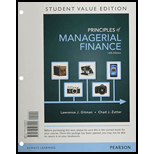
Scenario: Company ANZ recorded 28% increase in the year 2013 which is roughly $100 million despite they recorded only 4% increase in operating revenue. The currency hedging program incurred loss of $46 million the previous year but added $3 million to the revenue the following year which is the program accounted $49 million.
Many companies try to hedge the risk of multiple currencies by investing in financial instruments like forward, future contracts and options. To determine the quantity of financial instruments a firm should use, it must estimate the revenues it would receive and expenses it will pay in multiple currencies.
To determine: The impact of rise in Country N currency on airline profits.
Explanation of Solution
Impact of rise in Country N currency on airline profits:
The profit of the airlines will increase when the currency of country N rises. The rise in currency value of country NZ will decrease the operating cost for the company which in turn will increase the profit of the company.
Want to see more full solutions like this?
Chapter 19 Solutions
Principles of Managerial Finance, Student Value Edition Plus NEW MyLab Finance with Pearson eText -- Access Card Package (14th Edition)
- Hello tutor need barrow_forwardMoose Enterprises finds it is necessary to determine its marginal cost of capital. Moose’s current capital structure calls for 50 percent debt, 30 percent preferred stock, and 20 percent common equity. Initially, common equity will be in the form of retained earnings (Ke) and then new common stock (Kn). The costs of the various sources of financing are as follows: debt, 9.6 percent; preferred stock, 9 percent; retained earnings, 10 percent; and new common stock, 11.2 percent. a. What is the initial weighted average cost of capital? (Include debt, preferred stock, and common equity in the form of retained earnings, Ke.) b. If the firm has $18 million in retained earnings, at what size capital structure will the firm run out of retained earnings? c. What will the marginal cost of capital be immediately after that point? (Equity will remain at 20 percent of the capital structure, but will all be in the form of new common stock, Kn.) d. The 9.6 percent cost of debt referred to earlier…arrow_forward7. Berkeley Farms wants to determine the minimum cost of capital point for the firm. Assume it is considering the following financial plans: Cost (aftertax) Weights Plan A Debt .................................. 4.0% 30% Preferred stock .................. 8.0 15 Common equity ................. 12.0 55 Plan B Debt .................................. 4.5% 40% Preferred stock .................. 8.5 15 Common equity ................. 13.0 45 Plan C Debt .................................. 5.0% 45% Preferred stock .................. 18.7 15 Common equity ................. 12.8 40 Plan D Debt .................................. 12.0% 50% Preferred stock .................. 19.2 15 Common equity ................. 14.5 35 a. Which of the four plans has the lowest weighted average cost of capital? Use the Kd (cost of debt) = Y(1 - T), Kp (Cost of preferred stock) = Dp/Pp - F, Ke = D1/P0 + g formulas or I will not understand.arrow_forward
- Need use the Kd (cost of debt) = Y(1 - T), Kp (Cost of preferred stock) = Dp/Pp - F, Ke = D1/P0 + g formulas or I will not understand. Delta Corporation has the following capital structure: Cost Weighted (after-tax) Weights Cost Debt 8.1% 35% 2.84% Preferred stock (Kp) 9.6 5 .48 Common equity (Ke) (retained earnings) 10.1 60 6.06 Weighted average cost of capital (Ka) 9.38% a. If the firm has $18…arrow_forwardDelta Corporation has the following capital structure: Cost Weighted (after-tax) Weights Cost Debt 8.1% 35% 2.84% Preferred stock (Kp) 9.6 5 .48 Common equity (Ke) (retained earnings) 10.1 60 6.06 Weighted average cost of capital (Ka) 9.38% a. If the firm has $18 million in retained earnings, at what size capital structure will the firm run out of retained earnings? b. The 8.1 percent cost of…arrow_forwardDillon Enterprises has the following capDillon Enterprises has the following capital structure. Debt ........................ 40% Common equity ....... 60 The after-tax cost of debt is 6 percent, and the cost of common equity (in the form of retained earnings) is 13 percent. What is the firm’s weighted average cost of capital? a. An outside consultant has suggested that because debt is cheaper than equity, the firm should switch to a capital structure that is 50 percent debt and 50 percent equity. Under this new and more debt-oriented arrangement, the after-tax cost of debt is 7 percent, and the cost of common equity (in the form of retained earnings) is 15 percent. Recalculate the firm’s weighted average cost of capital. b. Which plan is optimal in terms of minimizing the weighted average cost of capital?arrow_forward
 Essentials Of InvestmentsFinanceISBN:9781260013924Author:Bodie, Zvi, Kane, Alex, MARCUS, Alan J.Publisher:Mcgraw-hill Education,
Essentials Of InvestmentsFinanceISBN:9781260013924Author:Bodie, Zvi, Kane, Alex, MARCUS, Alan J.Publisher:Mcgraw-hill Education,

 Foundations Of FinanceFinanceISBN:9780134897264Author:KEOWN, Arthur J., Martin, John D., PETTY, J. WilliamPublisher:Pearson,
Foundations Of FinanceFinanceISBN:9780134897264Author:KEOWN, Arthur J., Martin, John D., PETTY, J. WilliamPublisher:Pearson, Fundamentals of Financial Management (MindTap Cou...FinanceISBN:9781337395250Author:Eugene F. Brigham, Joel F. HoustonPublisher:Cengage Learning
Fundamentals of Financial Management (MindTap Cou...FinanceISBN:9781337395250Author:Eugene F. Brigham, Joel F. HoustonPublisher:Cengage Learning Corporate Finance (The Mcgraw-hill/Irwin Series i...FinanceISBN:9780077861759Author:Stephen A. Ross Franco Modigliani Professor of Financial Economics Professor, Randolph W Westerfield Robert R. Dockson Deans Chair in Bus. Admin., Jeffrey Jaffe, Bradford D Jordan ProfessorPublisher:McGraw-Hill Education
Corporate Finance (The Mcgraw-hill/Irwin Series i...FinanceISBN:9780077861759Author:Stephen A. Ross Franco Modigliani Professor of Financial Economics Professor, Randolph W Westerfield Robert R. Dockson Deans Chair in Bus. Admin., Jeffrey Jaffe, Bradford D Jordan ProfessorPublisher:McGraw-Hill Education





